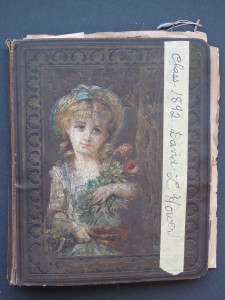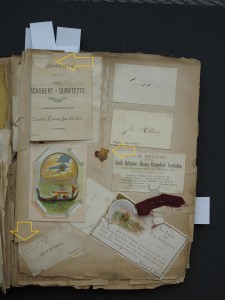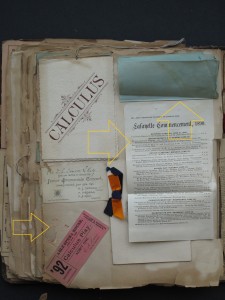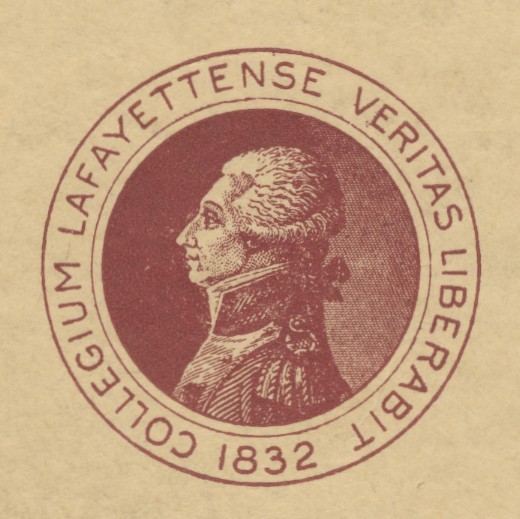Scrapbooks
 Who doesn’t love a good scrapbook? This kid, not anymore, at least not initially. Maybe I should explain. Growing up, I was one of the kids who save little mementos from important events in my life with the intention of one day putting them together in a scrapbook. When I first started to become interested in the archives, I was drawn to these multidimensional items because I felt that on some level I understood why they had been created and what they represented for their creator.
Who doesn’t love a good scrapbook? This kid, not anymore, at least not initially. Maybe I should explain. Growing up, I was one of the kids who save little mementos from important events in my life with the intention of one day putting them together in a scrapbook. When I first started to become interested in the archives, I was drawn to these multidimensional items because I felt that on some level I understood why they had been created and what they represented for their creator.
Looking back now, I can’t help but feel like I should have known better. After all, I was warned. How many times I was I told that once you start the processing an item, you can never see that material in the same way. This is exactly what happened to my relationship with scrapbooks. As something you are flipping through in your attic, scrapbooks are fascinating links to an earlier time, chalk full of a plethora of materials that instantly transport you to another place in history. In an archive, however, scrapbooks are a mixed bag of preservation nightmares. That same bunch of mixed materials, the pressed flowers, photographs, newspaper clippings and programs that were seemed so precious in your attic, each require a different method of preservation. The trouble with scrapbooks is that you never know what you are “going to get” until you begin to process the book and go through it, page by page, making decisions about best practices for stabilizing the material. For the years that the scrapbook has gone uncared for, both the material and the pages on which the material is affixed have been breaking down. Pages become discolored and brittle, breaking and flaking with every turn of the page. The mixed materials can actually “hurt” each other as materials of different natures react with each other.

 Suddenly, it all seems so overwhelming and you start to think, maybe I would give up, let the scrapbook sit on a shelf for a few more years. I ask you not to lose hope! There is a light at the end of the tunnel. One day you are given a project involving a scrapbook and in spite of your initial reaction to run, you start to critically go over the different materials that the author carefully selected for each page and the magic starts to show itself once more.
Suddenly, it all seems so overwhelming and you start to think, maybe I would give up, let the scrapbook sit on a shelf for a few more years. I ask you not to lose hope! There is a light at the end of the tunnel. One day you are given a project involving a scrapbook and in spite of your initial reaction to run, you start to critically go over the different materials that the author carefully selected for each page and the magic starts to show itself once more.
I had such an experience this semester when I was asked to look at the scrapbook of David L. Hower, Class of 1892 in order to mark a few pages that exemplified his time here, on campus. Upon first look, it seems as though this is a generic scrapbook of a student from the 1890s full of programs and other printed materials from Mr. Hower’s four years at Lafayette and I was afraid that I could not capture his experience with what I was given. Ready for the magic? I closely looked at each material and saw that many of them were covered with the light penciling of a person who not only attended concerts, sports games, contests and lectures, but carefully recorded what happened and his reactions. The materials revealed to me what activities on campus spoke to his interests. Mr. Hower did not fill his scrapbook with clippings and programs that featured his name. Instead he shared with future generations mementos from the events that he attended.
I will not lie and pretend that, as an archival assistant, I have a good relationship with Mr. Hower’s scrapbook. The corners of the pages still flake all over my workspace and his penchant for attaching multipage documents bewilders me. But as a History major, this scrapbook fascinates me because of the secrets that it holds within its pages. So what happens? Preservation. Proper preservation for scrapbooks can make them more accessible for the public so that in the years to come, this scrapbook is still functional.

Leave a Reply